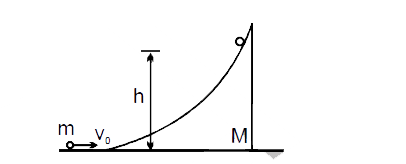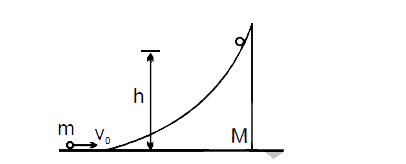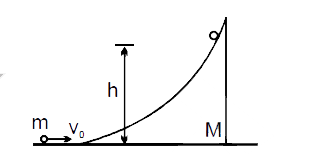A particle of mass 0.01 kg moving horizontally with velocity 20 m/s strikes a stationary wedge ABC of mass 0.05 kg with a velocity of 20 m/s near the apex of the wedge is free to move. Second collision of the particle with the wedge occurs at B. Find.
(a) the length AB of the wedge
(b) the normal reaction between the ground and the wedge during the first collision. [Given that angle θ=cot−1 (2)]
![A particle of mass 0.01 kg moving horizontally with velocity 20 m/s strikes a stationary wedge ABC of mass 0.05 kg with a velocity of 20 m/s near the apex of the wedge is free to move. Second collision of the particle with the wedge occurs at B. Find. (a) the length AB of the wedge (b) the normal reaction between the ground and the wedge during the first collision. [Given that angle theta = cot^(-1) (2)]](https://d10lpgp6xz60nq.cloudfront.net/physics_images/FIITJEE_PHY_MB_01_C01_E02_021_Q01.png)
The correct Answer is:(a) 1.8 m (b) 0.5 N
Topper's Solved these Questions
- COLLISION BOOK - FIITJEECHAPTER - COLLISION EXERCISE - ASSIGNMENT PROBLEMS (OBJECTIVE) Level - I
45 Videos
- COLLISION BOOK - FIITJEECHAPTER - COLLISION EXERCISE - ASSIGNMENT PROBLEMS (OBJECTIVE) Level - I (ASSERTION REASONING TYPE)
2 Videos
- COLLISION BOOK - FIITJEECHAPTER - COLLISION EXERCISE - ASSIGNMENT PROBLEMS (SUBJECTIVE) Level - I (Numerical)
8 Videos
- AC CIRCUITSBOOK - FIITJEECHAPTER - AC CIRCUITSEXERCISE - ASSERTION REASONING TYPE
1 Videos
- CURRENT ELECTRICITYBOOK - FIITJEECHAPTER - CURRENT ELECTRICITYEXERCISE - Comprehension -4
3 Videos
Similar Questions
A particle of mass m moving horizontal with v0 strikes a smooth wedge of mass M, as shown in figure. After collision, the ball starts moving up the inclined face of the wedge and rises to a height h.

The final velocity of the wedgev2 is
View SolutionA particle of mass m moving horizontal with v0 strikes a smooth wedge of mass M, as shown in figure. After collision, the ball starts moving up the inclined face of the wedge and rises to a height h.

When the particle has risen to a height h on the wedge, then choose the correct alternative(s)
View Solution
Knowledge Check
A block of mass m is placed on a smooth wedge of inclination θ & mass M. The whole system is slip on the wedge. Then the normal reaction on the wedge acting from the ground :
A(M+m)gB(M+msinθ)gCMgD(M+msinθM+m)gcosθA small ball of mass 1kg strikes a wedge of mass 4kg horizontally with a velocity of 10m/s. Friction is absent everywhere and collision is elastic. Select the incorrect answer:
 Athe horizontal component of linear momentum of the system (wedge+ball ) during the collision will remain conservedBthe linear momentum of the system (wedge+ball) will remain conserved during the collisionCthe component of linear momentum of the ball along common tangent will remain same during the collisionDthe linear momentum of the ball along common normal will change during collision
Athe horizontal component of linear momentum of the system (wedge+ball ) during the collision will remain conservedBthe linear momentum of the system (wedge+ball) will remain conserved during the collisionCthe component of linear momentum of the ball along common tangent will remain same during the collisionDthe linear momentum of the ball along common normal will change during collision
A particle of mass m moving horizontal with v0 strikes a smooth wedge of mass M, as shown in figure. After collision, the ball starts moving up the inclined face of the wedge and rises to a height h.

Choose the correct statement related to the wedge M
View SolutionA particle of mass m strikes normally to a stationary wedge of mass 5m kept on the smooth horizontal surface as shown.If the particle sticks to the wedge then loss in kinetic energy of the system during collision is?
View SolutionA particle of mass m moving horizontal with v0 strikes a smooth wedge of mass M, as shown in figure. After collision, the ball starts moving up the inclined face of the wedge and rises to a height h.

Choose the correct statement(s) related to particle m
View SolutionA 250 g ball moving horizontally with velocity 10.0m/s strikes inclined surface of a 720g smooth wedge as shown in the figure. The wedge is placed at rest on a frictionless horizontal ground. If the coefficient of restitution is 0.8, calculate the velocity of the wedge after the impact.

View SolutionA particle of mass m moving horizontal with v0 strikes a smooth wedge of mass M, as shown in figure. After collision, the ball starts moving up the inclined face of the wedge and rises to a height h.

The maximum height h attained by the particle is
View SolutionA small ball of mass 1kg strikes a wedge of mass 4kg horizontally with a velocity of 10m/s. Friction is absent everywhere and collision is elastic. Select the incorrect answer:

View Solution
